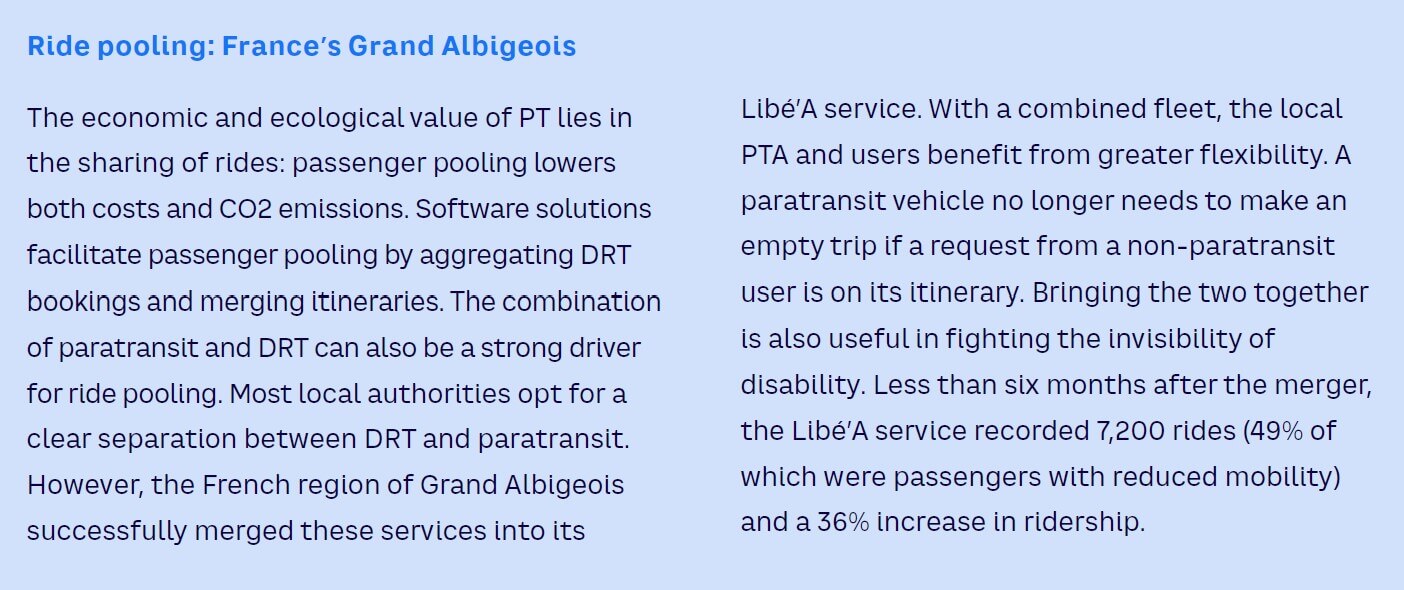
Empowered by technology and in line with customers’ digital habits, demand-responsive transport (DRT) is extending shared-mobility coverage and optimizing public transit. In this Viewpoint, we examine the extent to which DRT can help public transport authorities (PTAs) and public transport operators (PTOs) build more sustainable, resilient, and human-centric mobility systems.
TECHNOLOGY-ENABLED MOBILITY SERVICE
As PTOs look for ways to maximize the attractiveness and efficiency of shared mobility systems[1] and transition toward net zero, DRT is moving to the forefront. On-demand transport services have been part of public transport, but in a limited way:
-
Traditional on-demand transport was initially intended to run mainly as a service for people with disabilities and the elderly in rural areas.
-
Prebooking has been a key characteristic of on-demand transport, with rides usually scheduled the day before pickup but sometimes requiring one or two weeks’ notice.
-
Service offerings have been mostly siloed, and different types of beneficiaries are not mixed.
The first DRT schemes resulted in more questions than answers. Adoption and pooling rates were low, drivers’ paths had to be manually mapped each morning, and costs were high (euros spent per passenger-kilometer [PAX-km][2]) for the PTAs and PTOs that launched the initiatives.
In a 2020 Viewpoint (see “Rethinking On-Demand Mobility”), Arthur D. Little (ADL) examined on-demand solutions more broadly and concluded that the success of such services would “depend on the ability of public transit operators to develop the required levels of agility to run services which are, by definition, less predictable than their historical offerings.” Now, on-demand mobility is more mature, and there is segmentation between private services (ride hailing) and public services (DRT) — see Figure 1. However, DRT has remained a niche market and lacks integration into global mobility strategies. Four years ago, at the genesis of DRT, we raised several questions in that Viewpoint; the main question was the extent to which on-demand could complement or replace public transit. Both have been attempted over the past few years, with mixed results.
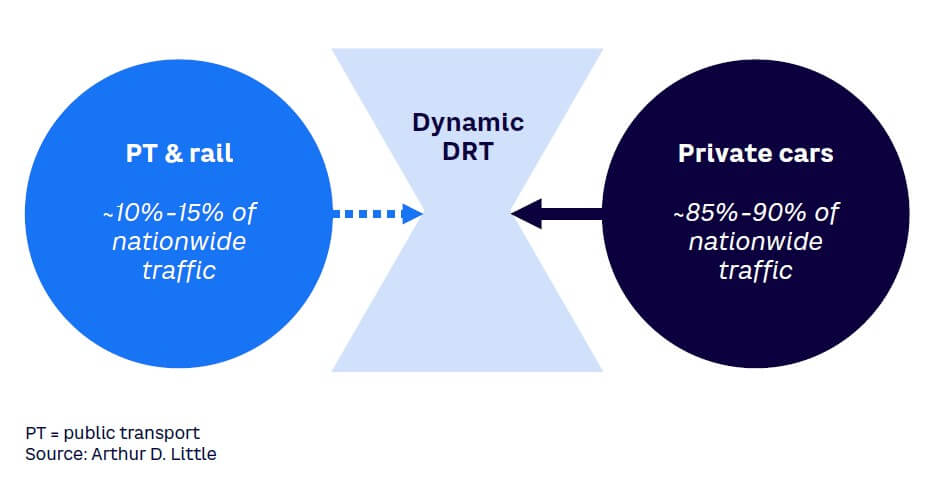
That Viewpoint also concluded that:
“On-demand solutions may well prove to be harmonious complementary services to public transit and, in some cases, replace fixed-route/fixed-schedule services, provided there is a business case based on accurate demand planning and sound cost-benefit analysis. However, the extent to which these solutions will be operated by private and public players in the future is still to be defined. The answer will depend on the ability of public transit operators to develop the required levels of agility to run services which are, by definition, less predictable than their historical offerings. It will also depend on whether private players can achieve the appropriate level of flexibility as they work with a number of different stakeholders, developing services to address the public interest at large. That said, we have no hesitation in recommending that operators experiment further as they assess the opportunities in on-demand public transit.”
What has happened since we wrote those lines four years ago? On-demand transport is mutating as the result of the following:
-
Higher equipment rates for smartphones with extended 4G/5G coverage
-
Better access to mobility-flow data
-
Rise of algorithmic solutions powered by data science/artificial intelligence (AI) and delivered through software-as-a-service (SaaS) platforms
Today, there are three key questions to consider:
-
Could DRT solve the lack of flexibility found in traditional on-demand transport (which requires booking hours or days in advance and handcrafting daily routes)?
-
Could DRT expand the addressable public transport market by serving a wider range of users?
-
Could better optimization (specifically through pooling) enhance DRT’s financial viability and coverage rate?
A LARGE ARRAY OF OFFERS
Based on expert views and market analysis completed by ADL’s Mobility Competence Center, we estimate there have been ~1,400 DRT projects initiated around the globe, with close to 1,000 still active. We continue to observe an increase in the number of DRT projects. ADL has gathered valuable insights on DRT, including:
-
DRT is versatile and addresses multiple use cases, including extending service coverage, partial substitution for traditional bus networks, and grouping of individual trips.
-
Under certain circumstances, DRT can optimize costs of public transport (PT), due to lower costs associated with fuel efficiency, smaller vehicles, and operating only when necessary.
Public transport requires high volumes of passengers to be efficient, and DRT enables expansion to both low-density areas (peri-urban and rural) and in low-demand situations (nights, weekends, holidays, suburb-to-suburb journeys, and other specific origin-to-destination journeys).
DRT has been introduced in many cities and territories as a way to:
-
Extend a bus network in a rural area where PT operators need to cover large zones with low density. Traditional bus lines often rely on under-satisfying service (there are not enough buses during the day and/or the routes do not match people’s needs), which ends up being high cost because the service drives little traffic. Similar to a taxi service, a DRT system can provide virtually 100% coverage while maintaining sufficient flexibility to serve fluxtuating demand.
-
Assist a group of people with specific needs (e.g., people with reduced mobility or night workers).
-
Optimize the current PT offering by limiting the number of fixed-line bus stops to enhance the user experience.
-
Group individual rides or combine general-public DRT with paratransit.
DRTs cannot successfully serve all these customers simultaneously, so PTAs must focus on a few use cases (see Figure 2). Some PTAs have successfully implemented separate DRT services in the same geographic area, such as a paratransit service during the day and night bus service for young people.
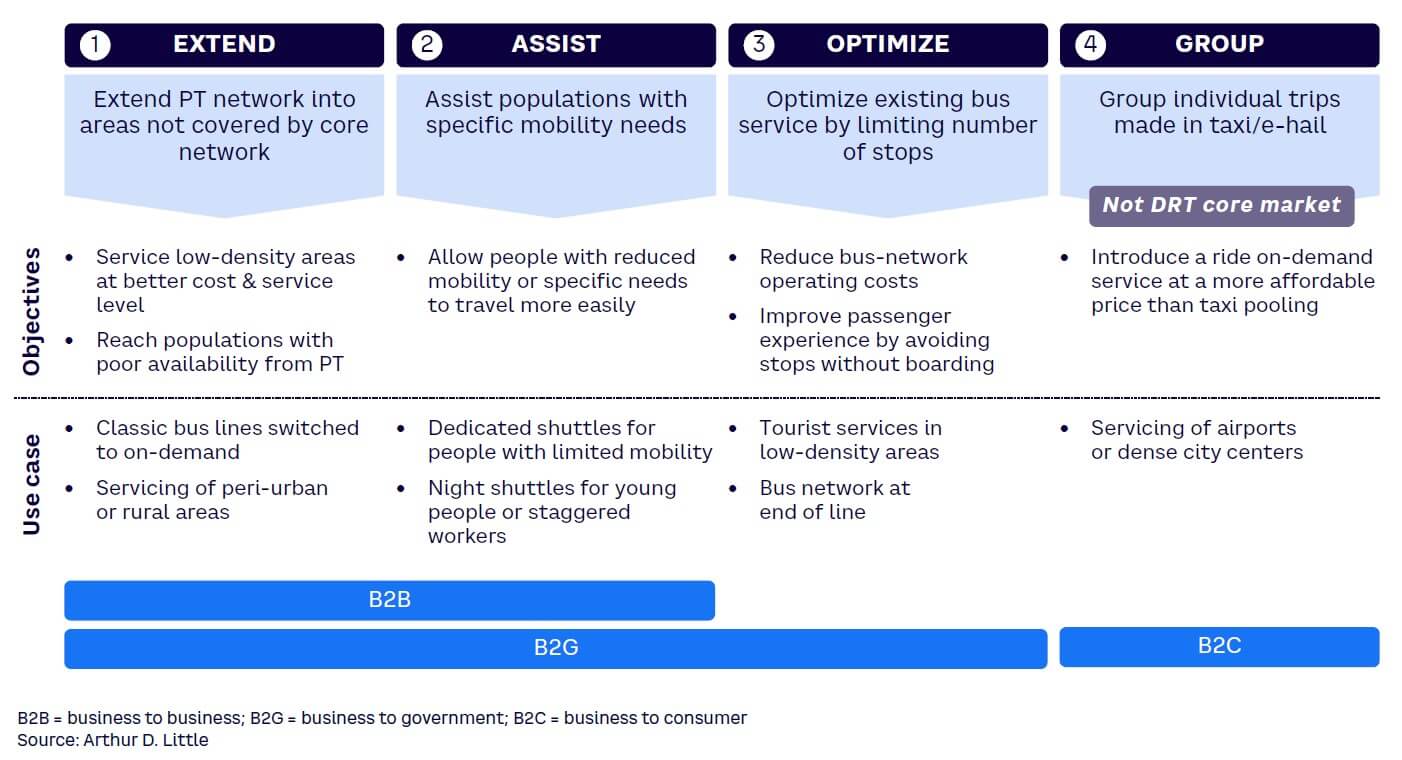
EXPLORING DRT’S FINANCIAL VIABILITY
Transit systems are generally sized to absorb peak-hour riders; the fact that DRT systems have no peak hours means its resources (e.g., buses and employees) are better used throughout the day. It may also allow DRT operators to use PT vehicles that usually sit idle during non-peak hours.
When discussing financial viability, it is important to first debunk the idea that on-demand transportation services can be profitable. Except in the case of shared taxi rides, DRT follows the traditional financing model of public transportation in most of the world, which includes subsidies.
On average, DRT services only generate a cost-coverage rate of between 5% and 15% (depending on the networks) compared to 15% to 40% for traditional bus services (see Figure 3). Even relatively high fares do not cover the costs of the service. It is therefore necessary to include it in the PT financing scheme and leverage the five success factors discussed below.
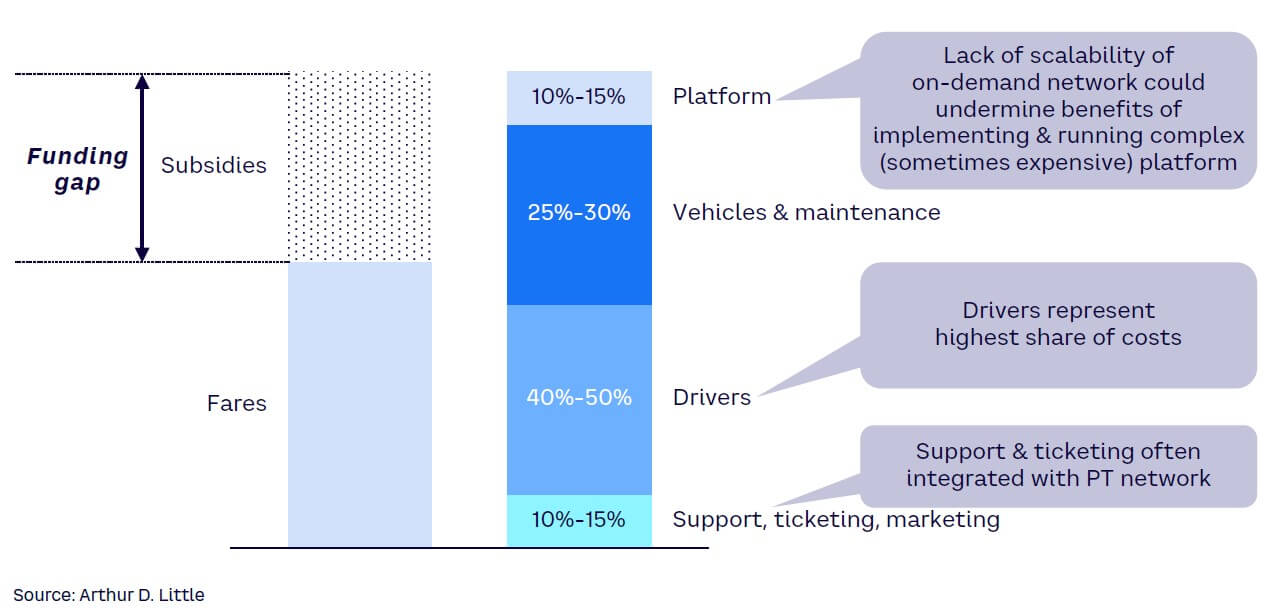
5 SUCCESS FACTORS FOR DRT IMPLEMENTATION
1. Combine clear objectives with a customer-centric approach
A DRT implementation must have clear objectives and take a customer-centric approach. As discussed, DRT is not a one-size-fits-all solution. Rather, it’s a targeted response to specific transportation challenges, including optimizing existing on-demand offerings, expanding service coverage, partially replacing a bus network, and/or facilitating the grouping of individual trips.
PTAs should consider conducting both in-house and external analyses to assess DRT’s potential in their area and identify success factors with an eye toward creating seamless journeys that address passenger concerns before initiating service. Note that preliminary analyses on both strategic and operational aspects have a better ROI than a quick go-to-market without studies.
There are four major pillars to consider when defining objectives:
-
Develop the service model that best fits the area’s mobility patterns. Some models may require a trade-off between service performance and population covered (e.g., a high-frequency service in a specific route versus a zonal DRT covering a large geographic area). By carefully analyzing user demographics, travel patterns, and preferences, PTAs can tailor their model to user needs.
-
Maximize visibility. DRT systems lack physical stops and dedicated infrastructure. Investing in vehicle coverings and leveraging existing marketing channels (particularly in areas with an established public transit network such as metro stations or core network bus stops) can help users become aware of the service.
-
Avoid redundancy. Integrating the service into existing, widely used applications has proven more efficient than creating a separate app. This may include the core network app, a mobility-as-a-service app, a national rail operator app, or the PT app used by the nearest metropolis (in rural areas). Exploring integration opportunities with popular local or global apps (where relevant from economic, strategic, and legal perspectives) can further enhance accessibility.
-
Make the user journey simple. This requires providing an omnichannel ride-booking solution (phone or app) and integrating fares within the core network fare system (or making it free for a wide range of the public, as fares do not fund the service anyway). Although DRT is a digital-native solution, offering non-digital options such as phone bookings or requesting stops directly from the bus driver enhances the user experience.
2. Deploy the right offering
DRT services can be operated using various models (see Figure 4). Each DRT model has advantages and disadvantages. Although certain models are specifically tailored to meet user requirements (e.g., door-to-door services for disabled persons), most universal on-demand services take one of these approaches:
-
Zonal approach. Service is offered in the entire area, regardless of destination. This maximizes geographic coverage, reduces travel time to bus stops, and results in higher service quality, including door-to-door pickup and drop-off. However, it’s difficult to efficiently pool rides, resulting in higher per-passenger costs. This type of service also has limited development potential due its maximum traffic capacity. This approach is appropriate in:
-
Dense urban areas with high potential for ride pooling, through mostly a corner-to-corner service. Most premium services offer a door-to-door solution (e.g., MOIA in Hamburg, Germany), but this is in direct competition with taxis and ride-hailing services, making it more expensive than other DRT services.
-
Low-demand rural areas where the service is offered to virtually everywhere inside to a specific destination. In Mole Valley (Surrey, UK), this door-to-door setting is combined with free-floating and feeder-service configurations, offering intra-zone transportation while linking people to the train station. It can also be used as a door-to-door service in a city, but being the most expensive model, it is usually only feasible for paratransit and elderly transport systems (e.g., Paris’s PAM [Pour Aider à la Mobilité] service).
-
-
Axial approach. Service is provided along specific routes or axes. This approach maximizes passenger pooling, since operations are close to a regular bus service, and reduces total travel time for most trips. It is also a straightforward user experience, as passengers can easily understand the service’s route. However, the axial approach results in fewer bus stops along an axis, potentially covering a smaller population within a given area. This service can operate:
-
With fixed virtual bus stops, such as Illévia Réservation in France, which links peri-urban areas of Lille to the city center with 21 virtual lines. Virtual bus stops tend to have limited visibility, which can be uncomfortable for some passengers.
-
With higher routes and timetables flexibilities, meaning operations run closer to a traditional bus network, as with Mufmi Malaga’s large on-demand bus network in Spain.
-
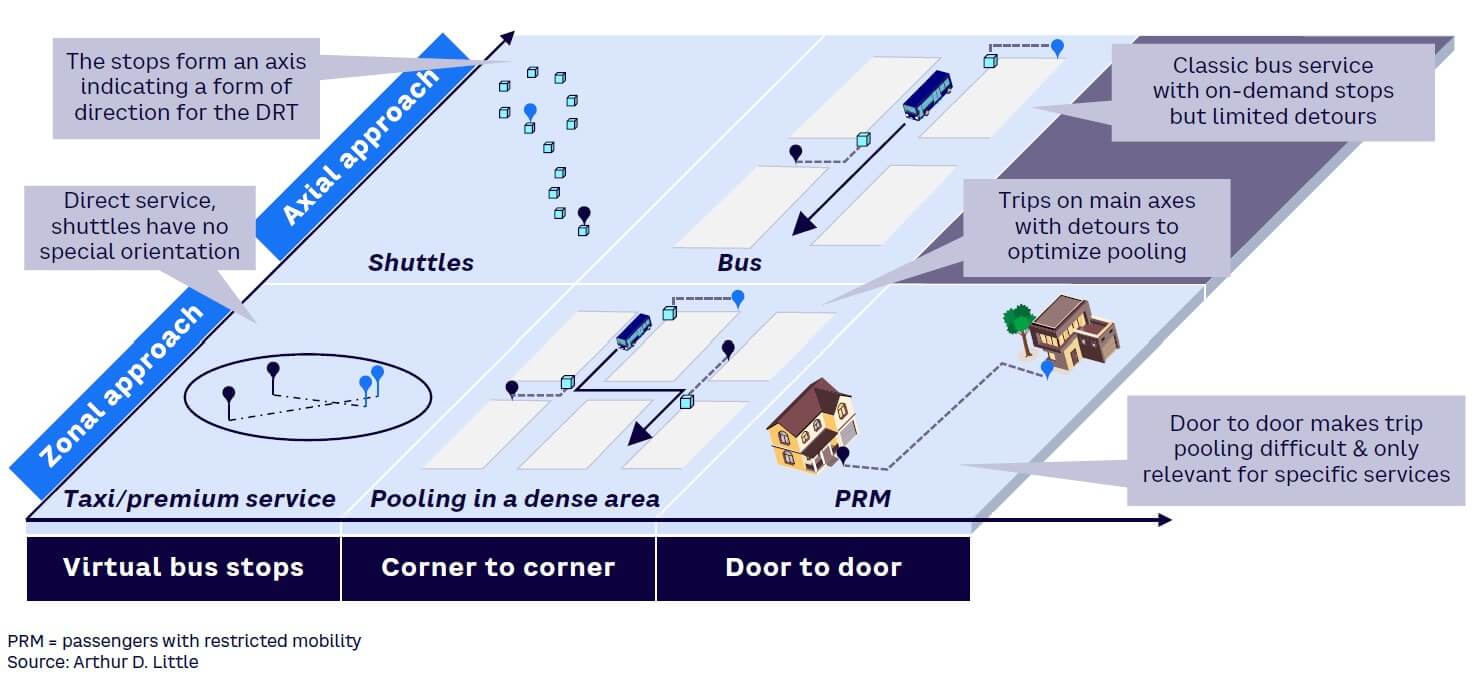
It is also possible to combine operational models, such as mixing a traditional bus line with an innovative DRT service. In Orléans, France (a 300,000-inhabitant metropolis), tramway and regular bus lines are connected with and complemented by an on-demand network outside the city center. A regular fixed bus line would have cost more than €4 per km; a smaller DRT shuttle, adapted to demand, costs much less. Complementary features such as non-competition with existing fixed lines allow PTAs to adapt DRT timetables to favor fixed lines when they exist, improving pooling rates.
3. Select the appropriate industrial model
Depending on the legal framework and level of competition in their mobility market, PTAs have three main options for DRT services (see Figure 5). These two questions can help them select the appropriate model:
-
To what extent should DRT be handled internally? This decision depends largely on the capabilities of the PTA or PTO. Direct operation is the preferred model, and this is the standard way of service when the PTO is run in-house (e.g., in networks such as Stuttgart’s SSB Flex in Germany or Pfaffenhofen’s Expressbus in Switzerland). However, this is not possible in all cases/countries.
-
If it should be outsourced, should there be one or two operators? In some cases, it’s more suitable to outsource operations to outside operators. However, outsourcing the service to two operators (e.g., a PTO and an SaaS player like Padam Mobility) is not always the best option. With two operators, the transport company is usually in charge of rolling stock management and driving, and the SaaS is in charge of spreading the trips. In some cases, it’s more efficient to outsource it to a single operator that either develops the necessary technological capabilities in-house or partners with a technology provider.
It is a good idea to conduct multiple tests aimed at identifying the most effective model prior to the operationalization phase. Given the innovative nature of DRT, beginning the service in minimal viable product mode makes sense — allowing incremental adjustments and expansion as the project scales.
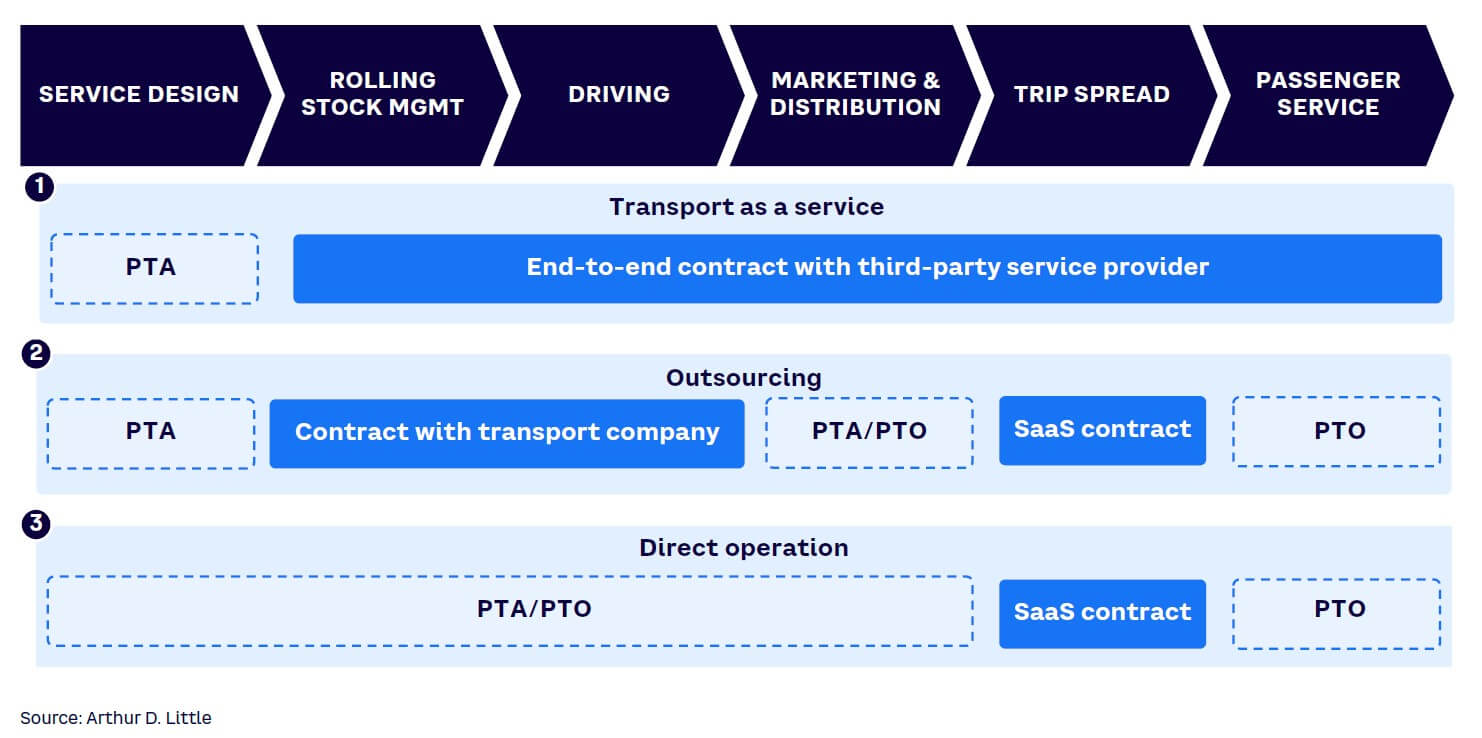
4. Define the best pricing
PTAs typically have three fares options when implementing a DRT service (see Figure 6):
-
Integration with the PT fare system. We strongly recommend this option, especially in urban or peri-urban areas where there is a well-established PT network. Integrating DRT fares into the existing fare system offers a seamless experience for passengers and promotes use of the service. For instance, Paris’s TAD IDFM uses the same fares across the region, letting users access any TAD IDFM service with their T+ tickets or Navigo cards. By establishing a strong visual identity that matches the traditional network, PTAs foster a sense of familiarity among passengers that facilitates their connection with the service.
-
Applying a premium or surcharge on PT fare. PTAs may choose to implement a fee on top of the regular PT fare for DRT services. This option allows operators to set prices based on a varity of factors and can help cover the costs associated with providing on-demand services. However, higher fees definitely impact passenger perception of the system.
-
Building up special fares but at an equivalent level. This option is often preferred in rural areas and for special services, such as paratransit. Special fares can be established for DRT services, ensuring that the pricing remains comparable to other transportation options in the region. In some cases, services like paratransit may be offered free of charge to prioritize accessibility and inclusivity.
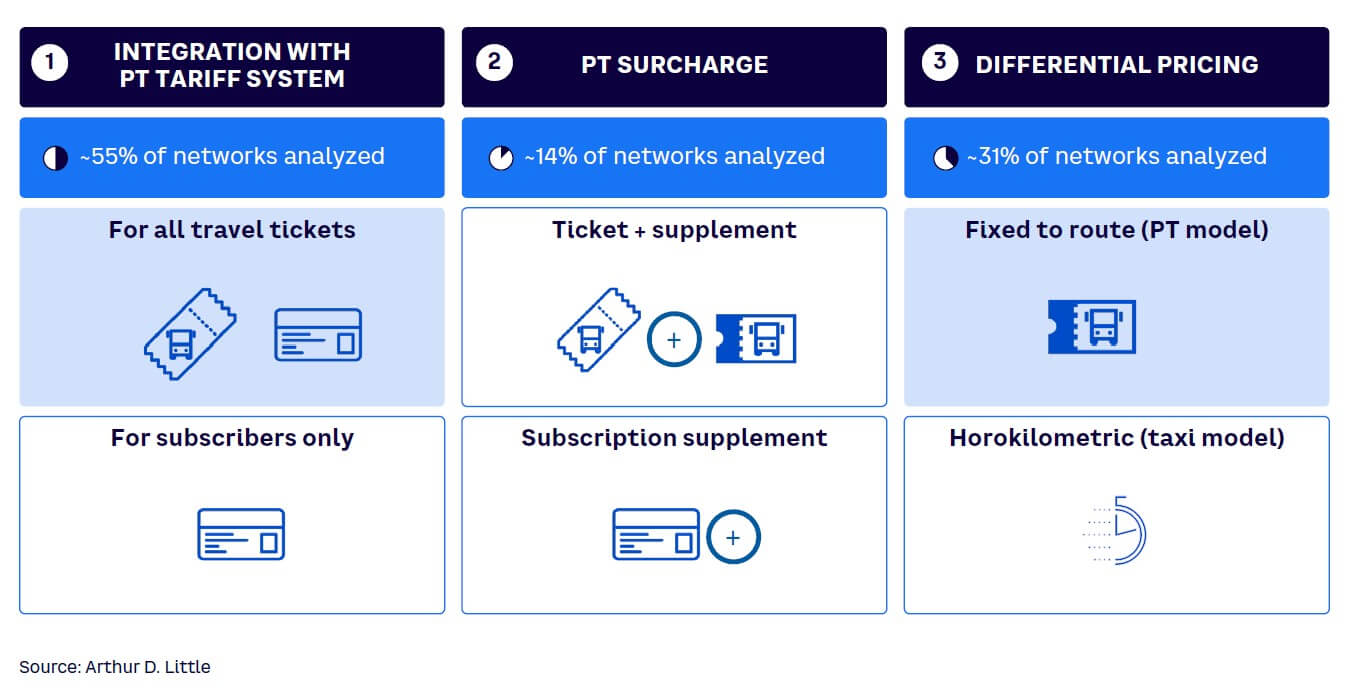
5. Take a data-driven approach
Gathering and analyzing data is a critical success factor for DRT. Robust data analysis provides valuable insights into the service’s operational dynamics and helps operators optimize them. It involves precise monitoring of KPIs such as:
-
Travel times — to understand user satisfaction and identify improvement areas
-
Passenger recurrence — to match the needs of recurring passengers, enhance routes, and develop effective marketing strategies
-
Occupancy rates — to identify bottlenecks, facilitate capacity and scheduling adjustments, and ensure optimal resource allocation
With a data-driven approach, PTAs can adapt their services to optimize costs while delivering a responsive experience.
Conclusion
A BOLD POSITION FOR MOBILITY STAKEHOLDERS
DRT has a strong potential to address PTA/PTO objectives with a better integration into global mobility strategies. Based on our analysis, there are three key considerations for stakeholders:
-
For PTAs. DRT represents an interesting option because it can contribute to modal shift by promoting shared mobility. However, comfort should not be the number one priority, as DRT should not be seen as a premium service like taxis.
-
For PTOs. Integrating DRT presents both challenges and opportunities for PTOs. It can be seen as a means to bring innovation and efficiency to PTAs, either before a bus tender award or during contracts to optimize their services. Operational challenges must be carefully addressed to ensure seamless implementation.
-
For service providers (fleet and tech). Demonstrating the added value of DRT compared to traditional bus services is crucial. Providers should focus on offering operators smooth and efficient fleet and driver management solutions.
Notes
[1] In this Viewpoint, a shared mobility system is defined as public transport (PT) plus new mobility services (e.g., active, shared, micro, and on-demand) acting as feeders for the first and last mile or complementing PT for trips to places not covered by PT.
[2] Passenger-kilometer is the common measurement unit in transport (1 PAX-km = 1 PAX x 1 km).

